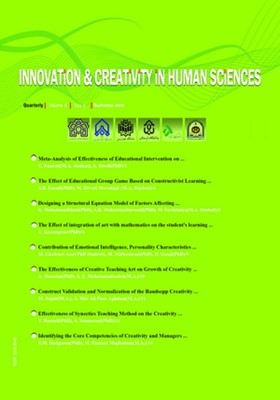The Effect of Educational Group Game Based on Constructivist Learning on Training of Creative Thinking Skill of preschool children
Subject Areas : Creativity and innovation from psychological, epistemological, educational and pedagogicalSeyed Rasoul emadi 1 , Mahin Orvati movafagh 2
1 - Faculty member of Literature and Human Sciences, Bu-Ali Sina University
2 - Student
Keywords: "group games", "creative thinking", "constructivist learning environment", "preschool children",
Abstract :
Background: training of creative thinking skill is what is needed for the future. In this way, improvement and enhancement of creative thinking in children as a necessary skills in age of communication, is required proportionality and applying new educational designing patterns and methods.Goal: the present research has been conducted with the aim of investigating the effect of educational group game based on constructivist learning environment pattern on training of creative thinking skill of preschool children.Method: this semi-empirical research has been implemented using pre-test and post-test with control group. Statistical population of the study was consisted of children of preschool institutions under the guise of State Welfare Organization of Iran in Hamadan city in school year of 2013-2014 which were selected using randomized cluster sampling method equal to 24 individuals in two groups of test and control. Form B of Torrance test of creativity thinking as pre-test and post-test was used in order to measure components of creativity, and group games were run for eight sessions just in test group.Results: results of covariance analysis indicated that training in the style of group games has effect on training of creative thinking skill of preschoolers.Discussion and conclusion: training in the style of group games can increase children’s creative thinking skill by a pleasant and enjoyable process.
بابایی، شهلا و اسلام پناه، مریم. (1393). بررسی نقش آموزش مبتنی بر بازیهای هدایت شده بر خلاقی تکودکان پیش دبستانی، مرودشت، اولین همایش ملی علوم تربیتی و روانشناسی، آذرماه93.
پارسا منش، فریبا؛ صبحی قراملکی، ناصر.(1392). تأثیر بازی های وانمودی شعر بر پرورش خلاقیت کودکان. فصلنامه ابتکار و خلاقیت در علوم انسانی. دوره 2, شماره 4.صص141-157.
پورسلیم، عباس، زمانی، الهام و کاظم منافی شرف آباد. (1393). تأثیریادگیری مشارکتی در تفکر خلاق دانش آموزا نپسر پایة پنجم ابتدایی شهرستان کوهدشت در درس علوم تجربی، مجله تفکروکودک، پژوهشگاه علوم انسانی و مطالعات فرهنگی، سال پنجم، شمارة اول، بهار و تابستان 1393،صص 1-19.
تورنس، الیس پل (1974). استعدادها و مهارتهای خلاقیت و راههـای آمـوزش و پـرورش آنهـا (ترجمـه حسن قاسمزاده).(1381). تهران: دنیای نو.
جلالی، سیده شادیه.(1391). تاثیر آموزش بازیهای وانمودی بر افزایش ابعاد خلاقیت د رکودکان پیش دبستانی. پایان نامه منتشر نشده کارشناسی ارشد. دانشگاه علامه طباطبایی، دانشکده روانشناسی و علوم تربیتی، گروه روانشناسی بالینی و عمومی.
حسنی، فریبا؛ محمودی، غلامرضا؛ تهرانی، ندا. (1392). اثربخشی لگو آموزشی بر افزایش هوش عملی و خلاقیت کودکان پیش دبستانی. فصلنامه تحقیقات روانشناختی، دوره5، شماره 20.
رادبخش، ناهید؛ محمدی فر، محمدعلی؛ کیان ارثی، فرحناز.(1392). اثربخشی بازی و قصه گویی بر افزایش خلاقیت کودکان . فصلنامه ابتکار و خلاقیت در علوم انسانی. دوره دوم. شماره 4.صص177-195.
ریچی، ریتاسی؛کلاین، جیمز دی؛ ترسی، مونیکا دبلیو.(2011). دانش پایه طراحی آموزشی؛ نظریه، پژوهش و عمل (ترجمه حسین زنگنه و الهه ولایتی(1391). تهران:آوای نور.
سیف هاشمی، فخرالسادات.(1383). رابطه خلاقیت و ویژگی های شخصیتی دانش آموزان دبیرستان های تهران، مجله نوآوریهای آموزشی، 3(7)،صص 12-24.
شهرآرای،مهرناز؛ سیدان،ابوالقاسم و فرزاد، ولی الله.(1381). تحلیل خلاقیت در کودکان: معرفی آزمون تفکر خلاق در عمل و حرکت. مجله روانشناسی و علوم تربیتی. سال 32. شماره 2. صص191-213.
فیروزی، زهرا؛ کرمی،مرتضی؛کارشکی،حسین؛سعیدی رضوانی، محمود.(1392). تاثیر کاربست الگوی جاناسن در یادگری مبتنی بر مسأله بر نگرش،رضایت و یادگیری در برنامههای آموزش ضمن خدمت معلمان.پژوهش در برنامه ریزی درسی.سال دهم، دوره دوم، شماره12.صص36-52.
کرمی، مرتضی .(1392). طراحی و سنجش تأثیر محیطهای یادگیری سازندهگرا بر رضایت، نگرش و یادگیری در آموزش عالی (مورد درس روابط انسانی در سازمان های آموزشی). فصلنامه انجمن آموزش عالی ایران، سال پنجم، شماره دوم. صص23-50.
یزدانی پور، نسیم؛ یزدخواستی، فریبا.(1391). اثربخشی بازیهای گروهی بر مهارتهای اجتماعی کودکان پیش دبستانی 6 تا 7 ساله شهر اصفهان. مجله تحقیقات علوم رفتاری. سال دهم، شماره 3، (پیاپی 24).صص221-228.
Berrueco, L. (2011). Effects of a play program on creative thinking of preschool children. Spanish Journal of Psychology, 14(2), 608-18.
Buendía-García, Félix; García-Martínez, Sol; Navarrete-Ibañez, Eva M and Cervelló-Donderis, M Jesús.( 2013). Designing Serious Games for getting transferable skills in training settings. Interaction Design and Architecture(s) Journal - IxD&A, N.19, 2013, pp. 47-62.
Crawford,C. (2004).”Non-linear Instructional Design model:eternal, synergistic design and development”.British Journal of Educational Technology.Vol 35,NO 4,PP 413-420.
Garaigordobil Maite, Berrueco Laura.(2011). Effects of a play program on creative thinking of preschool children. The Spanish Journal of Psychology, Vol. 14, No. 2, 608-618ISSN 1138-7416]. http://www.redalyc.org/pdf/172/17220620009. pdf.
Jones, P. A., Taylor, J., & Sutton, L. (2002). The effects of play on the creativity of young children. Early Child Development and Care, 172 (4), 323-328.
http://www.cse.cuhk.edu.hk/~jlee/publ/10/constructivistIGI10.pdf
Jonassen. David. (1999). Designing Constructivist Learning Environments. http://www.davidlewisphd.com/courses/EDD8121/readings/1999-Jonassen.pdf
Dilalla, L.F. (2005). Childhood Predictors of Later Creativity in Early Adolescence.Southern Illinois University.
Mendez JL, Fogle LM. (2002). Parental reports of preschool children's social behavior: Relations among peer play, language competence, and problem behavior. Journal of Psycho educational Assessment; 20(4): 370-85.
Mednick, S. A. (2009). The associative basis for the creative process. Psychological Bulletin, 69,pp: 220–232.
Tekina, Murat, Gullub, Mehmet (2010). Examined of creativity level of primary school students who make sports and do not make sports. Proscenia Social and Behavioral Sciences, 2 (2010), 3351–3357.
Tekin, M & Gullub, M. (2011). Examined of creativity level of primary school student who make sports and do not make sports. Proscenia Social and Behavioral Sciences, 2, 3351-3357.
Treffinger, J. D. (2008). Creativity and innovation. United Kingdom: Corwin press.
Tsz Ki, Lam. (2005). Developing creativity and problem solving through story telling for preschool children. The University of Hong Kong, http://www.dx.doi.org/ 10.5353/th_b3537294.
Wall, T.D. (2005). Creativity, innovation, Learning and knowledge Management in the Process of Service Development–Results from a Survey of Experts Journal of Applied Psychology, 90(50), 774-79.
Wilson, B.G. (1996).Introduction: What is a constructivist Learning environment? In B.G.Wilspn (Ed.), Constructivist learning environments: Case studies in instructional design (pp.3-10). http://carbon.cudernver.edu~bwilson/ theory.html.
_||_


